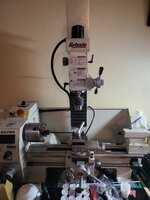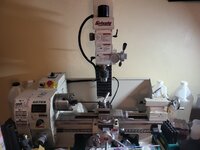I appreciate that but I'm interested in using it for metal and acrylic working and not expecting to learn it overnight. I'm willing to take my time to continue to perfect my craft.
@PENfinity
There are quite a few IAP members who use a metal-working lathe. I have turned 2500 pens on one over the last 15 years and displayed some of my work here. I have turned wood and acrylic pens mainly, but also some pens with aluminum and brass portions.
I suggest that you make a start by learning to mount a standard pen blank on your lathe and then turning it to a round cylindrical shape.
It can be wood or acrylic. Hopefully your lathe has variable speed (VS) control. Starting to learn will be at very low well-controlled speed.
For the turning tool I strongly suggest that you use a round carbide-tipped tool. Many tool stores stock these in suitable sizes.
First, though, you should tell us more about your lathe and show a couple of pictures. We need to know the lathe size and a few other details about your chuck, tailstock and banjo/tool rest combo. The banjo/tool rest details will guide us as to what size of tool you should buy.
As accessories for turning pens on the lathe, I suggest you have a 4-jaw scroll chuck, a dead center, and a live center suitable for the lathe.
You will also need a Jacobs chuck matched to your tailstock taper size (Morse taper 2, perhaps) for drilling axial holes in your pen blanks.
Before anyone can make more specific suggestions, though, you need to tell/show us some details about your lathe.
Obviously, since you Iive 3000+ miles from me, we cannot meet in person. There should be someone nearer you with whom you could meet.
But since you say that virtual assistance is a possibility then that is certainly available from quite a few people on IAP, including myself.
Have you any experience using a wood-turning lathe ? Just the matter of dealing safely with spinning objects would be a good start.
None of us who is chatting with you on this forum can assume any responsibility for your safety.
There should be folks at your local tool stores who can advise you about personal safety precautions and the necessary safety equipment.
BTW, what is the meaning of the "ISO" that you include in the title of your thread(s).



